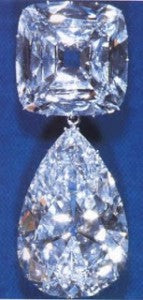2012 is an extraordinary year, not the least for the international celebration of Queen Elizabeth II’s Diamond Jubilee. In honor of the occasion, an exhibition will be on view at Buckingham Palace that showcases the entire Royal Collection and will include an unprecedented number of her majesty’s personal jewels. Displayed in this spectacular exhibit will be many diamonds with "histories", including the Cullinan diamond, first discovered in South Africa in 1905 as a single diamond.
When Captain Frederick Wells was making his inspection of the Premier Mine in Transvaal, South Africa, he stumbled upon a diamond twice the size of any he had ever seen. Convinced it was worthless, he sent the stone to be analyzed. His discovery turned out to be one of the most important gems in history.

The Imperial Sceptre of Great Britain, with the Great Star of Africa
The 3,106 carat diamond was found to be perfectly clear and colorless and was thus named after the chairman of the Premier Diamond Company, Sir Thomas M. Cullinan, who had discovered the mine in 1902. After causing world-wide attention, the diamond was given as a gift to King Edward VII as a symbol of loyalty and appreciation from his Commonwealth constituents. In order to get the now-famous stone across both land and sea and to its intended recipient, a clever combination of subterfuge and security was enlisted. First stowed in a hatbox of the wife of a South African postal employee, the stone was then sent via parcel post without declaring its full value, which would arouse attention. A dummy stone was also sent on the very same ship that carried the mail, stored safely in the captain’s cabin. When both stones reached their destination safely, the Cullinan was brought to King Edward the VII for inspection.
The Stars of Africa were sent to the Tower of London to be displayed with the rest of the Crown Jewels, along with the hammer and cleaver Joseph Asscher used to shape them. Afterwards, the largest stone, Cullinan I,—known as the Greater Star of Africa--and Cullinan II (the second largest) were brought to glory in the Sceptre with the Cross and the Imperial State Crown respectively. Cullinan III and Cullinan IV – the Lesser Stars of Africa – were set as a brooch by Queen Mary in 1910. The majestic brooch was the single most valuable item in her collection and was later inherited by Queen Elizabeth II, her granddaughter.
Today, as in over a century ago when these magnificent gems made their appearance, jewels define a monarch’s status. The image of royalty always includes spectacular jewels – symbolizing the power of the wearer and, by association, the people she reins. Queen Elizabeth II sought to be more than just adorned by the famous Stars of Africa and made a journey to the Asscher diamond works in the Netherlands during a State visit in 1958. The occasion marked the first time she wore the brooch, and she honored the elderly Louis Asscher by handing him the brooch that his brother had cleaved in his presence. The fascinating biography of the Cullinan gems represents the powerful charisma jewelry can bring to the wearer. As we celebrate Queen Elizabeth II’s Diamond Jubilee, let us also remember the legacy of her jewels. The exhibition will be held at Buckingham Palace until the 7 October, 2012 and it is a life time opportunity to admire these incredible gems.






